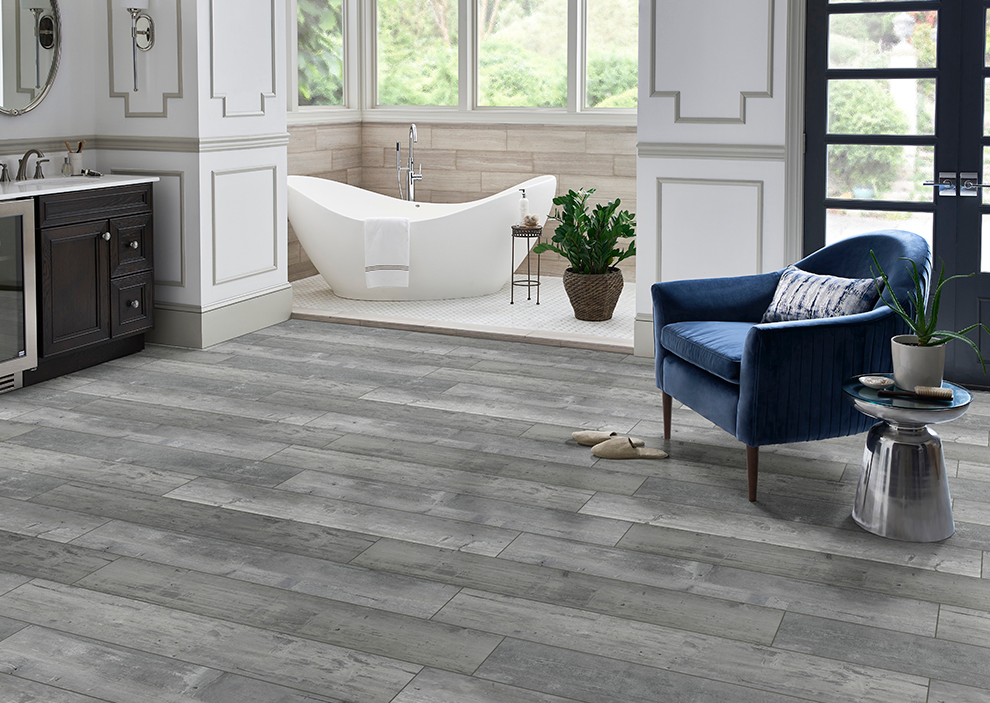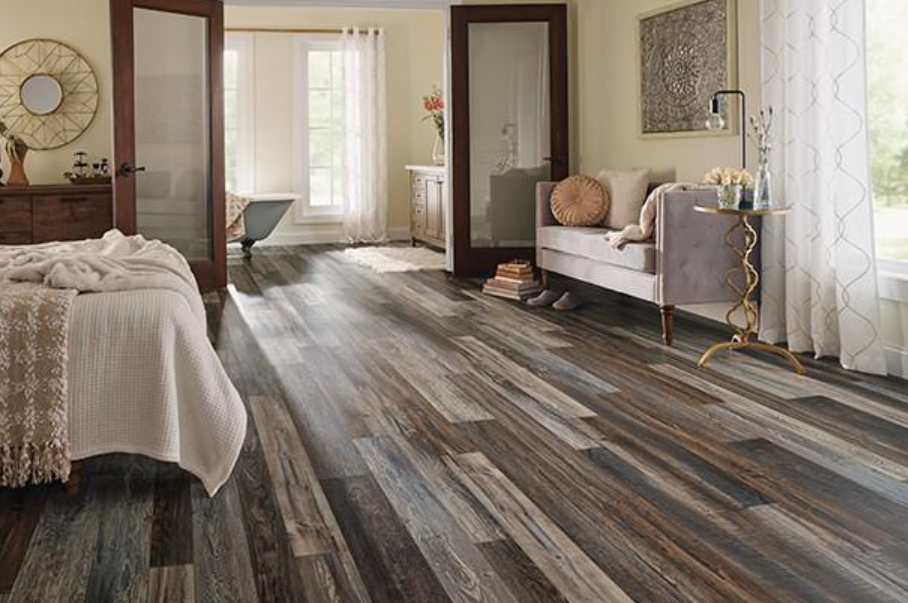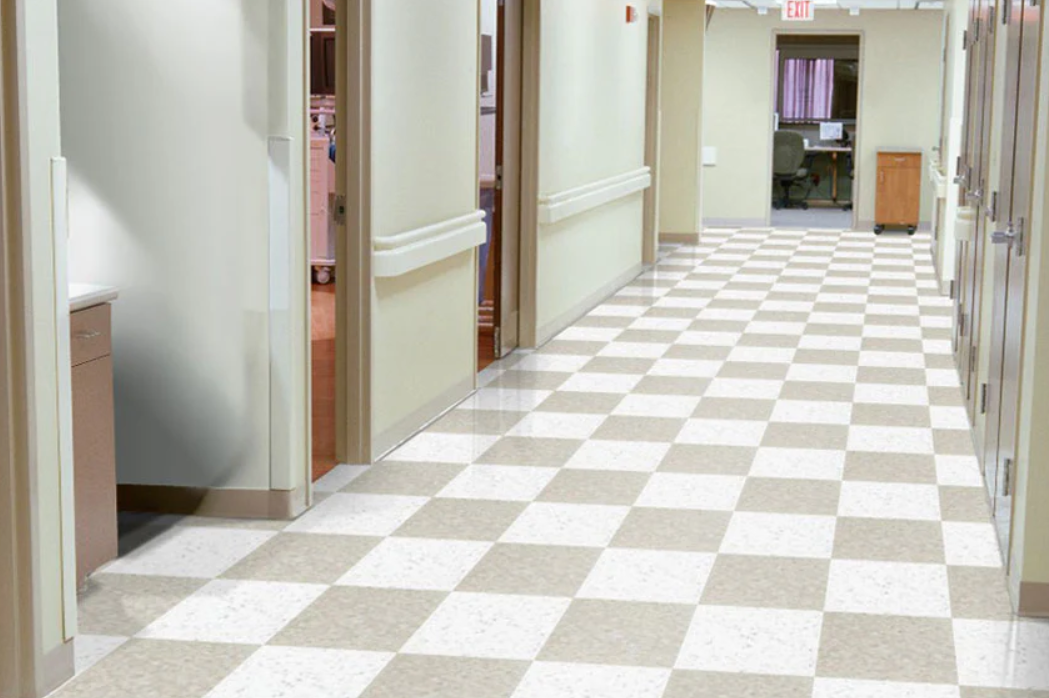A Guide to Commercial Vinyl Flooring
In my experience, commercial vinyl flooring is made for busy places. Think of offices, hospitals, restaurants, and stores. It’s a synthetic floor that’s tough, affordable, and resists stains and wear. I find it’s a great choice for any public or business space.
What Kinds of Commercial Vinyl Flooring Are There?
Vinyl flooring comes in three main types—sheet for cost-effective large-area coverage, LVT for a tile-like look with easy installation, and LVP for a wood-like appearance with added durability and low maintenance.
Types of Commercial Vinyl Flooring
To pick the right commercial vinyl floor, I think you first need to know the options. Each type has its own features, price, and is best for certain spaces.
Vinyl Sheet Flooring Big vinyl rolls (6′, 9′, 12′) mean fewer seams and faster installs—perfect for commercial vinyl flooring in large spaces on a budget. It’s clean, tough, and built for places like Hospital Flooring or healthcare vinyl where hygiene matters. You’ll find it in two types: homogeneous vinyl flooring (solid color, hides wear) and heterogeneous vinyl flooring (layered, adds style and performance).
Luxury Vinyl Tile (LVT)
LVT flooring nails that stone-look vinyl or ceramic-look vinyl without the cost or hassle. It’s strong enough for busy spots and easy to fix—just pop out a tile if it’s messed up. Solid pick for office flooring, hotel vinyl tile, restaurant floors, and anywhere that needs style and strength. Works well in retail vinyl flooring too.
Luxury Vinyl Plank (LVP)
LVP flooring gives you that wood-look vinyl plank vibe—textures and all—without the drama of real wood. It’s tough, low-maintenance, and handles foot traffic like a pro. Great for shop flooring, boutique floors, salons, or any biz that wants that warm, modern look without babying the floor. Perfect for commercial wood-look flooring needs.
Vinyl Composition Tile (VCT)
VCT flooring is that no-nonsense, hard-wearing tile you’ll see in schools, warehouses, and cafeterias. Cheap upfront, holds up under pressure, and easy to swap out a tile if it takes a hit. Not flashy—mostly solid colors—but gets the job done. Just be ready to wax it now and then. Still a favorite in industrial flooring and institutional vinyl flooring.
Peel and Stick Vinyl Peel-and-stick vinyl flooring is made for quick fixes and easy DIYs. Tons of designs—from wood-pattern self-adhesive vinyl to colorful vinyl stickers—but don’t expect it to handle heavy traffic. Perfect for small business flooring, pop-up shops, or breakroom updates that need a facelift on a tight budget. Great for quick-install vinyl flooring projects.
Comparison Table: Key Features & Applications
From my experience, picking commercial vinyl flooring is easier when you compare the key features. I suggest we look at durability, design options, moisture resistance, cost, and the best places to use each type.
| Type | Durability | Aesthetics & Design Flexibility | Moisture Resistance | Installation & Replacement | Cost | Ideal Applications |
|---|---|---|---|---|---|---|
| Sheet Vinyl | Good for general use. I find it’s less durable in very heavy traffic areas. | It has a good selection of colors and patterns. Some look like stone or wood, but with fewer choices. | Its resistance is very high. The seamless install prevents water issues. | It’s quick to install in large spaces. Repairs are tough; you may need to replace the whole sheet. | A great value option. I recommend it for big projects. | Hospitals, clinics, classrooms, and large retail stores. I also suggest it for spaces that need to be hygienic and simple to clean. |
| Luxury Vinyl Tile (LVT) | This is very tough. It handles heavy foot traffic well because it’s made with high pressure. | It offers a huge design variety. You can get stone, ceramic, abstract, or even custom styles. | It’s good. Individual tiles resist moisture, but there are more seams. | You can replace single tiles, which is very convenient. This allows for flexible patterns and layouts. | It costs more than sheet vinyl but less than ceramic. | I recommend LVT for offices, hotels, senior living homes, lobbies, retail shops, and medical offices. |
| Luxury Vinyl Plank (LVP) | This is an excellent choice for heavy use. It resists scratches, dents, and general wear. | It looks and feels like real wood. It comes in a wide range of natural textures. | Good. The planks are resistant to spills. Keep in mind it has multiple seams. | Installation is simple. You can install or replace one plank at a time for a fast turnaround. | The cost is similar to LVT. It is more expensive than sheet vinyl. | I like it for restaurants, boutique shops, and hotels. It’s great for spaces that want a branded or charming feel. |
Pros and Cons of Commercial Vinyl Flooring
If you are thinking about commercial vinyl flooring for your business, you need to weigh the good and the bad. From my experience, I’ve put together a simple look at the main pros and cons. I’ll include real cost figures and practical tips I’ve learned along the way.
The Good Things About Commercial Vinyl Flooring
Stands Up to Heavy Foot Traffic
Vinyl holds up well in busy spaces like lobbies, hallways, hospitals, and grocery stores.
Case example: In my experience, a quality LVT or sheet vinyl in a busy hospital corridor can last 10–20 years with correct maintenance.
Great for Wet Areas
Commercial vinyl is waterproof by design. It handles spills and moisture without swelling up or warping. I find it is a great choice for kitchens, entryways, and basements.
Simple and Cheap to Maintain
Routine cleaning is easy. You just need to sweep and mop. No special cleaners are necessary.
LVT and sheet vinyl require little ongoing care compared to carpet or VCT. Based on my work, VCT requires frequent waxing, which is a lot of effort.
Good Value for the Cost
The upfront cost is often lower than tile or hardwood.
VCT: This has the lowest material price. I recommend it for very large jobs like schools, warehouses, and cafeterias.
LVT: The initial investment is higher ($5–$10 per sq ft). I believe the low maintenance saves you money over time.
Lots of Design Choices
You can find options that look just like wood, stone, ceramic, and even abstract patterns.
I find that Luxury Vinyl Tile (LVT) gives you the most realistic and wide selection of looks. This helps with branding and gives you décor flexibility.
A Clean and Hygienic Option
Some sheet vinyl products have coatings that resist germs. This makes them a great floor for healthcare or lab settings.
Quiet and Comfortable Underfoot
Rigid-core LVT and floors with cushioned backs absorb sound. This makes them quieter to walk on. I suggest these for offices or classrooms.
Fast and Easy to Install
Installing vinyl is quick and simple. This helps speed up renovation projects and means less downtime for your business.
| Downside | Description & Suggestions |
|---|---|
| VCT Needs a Lot of Work | Vinyl composition tile is cheap to buy, but it needs regular waxing and stripping. The long-term upkeep costs can cancel out the initial savings. |
| Sheet Vinyl is Hard to Repair | If you damage a section of sheet vinyl, you might have to replace the entire piece. With LVT or LVP, you can just replace a single tile or plank. |
| Possible Air Quality Issues | Low-cost vinyl can release chemicals called volatile organic compounds (VOCs). To avoid this, I always suggest you choose certified, high-quality commercial products. |
| Can Fade in the Sun | UV light can cause vinyl colors to fade over time. My advice is to use window treatments in sunny rooms to protect the floor’s appearance. |
| Adds Little to Property Value | Vinyl flooring does not really increase the resale or asset value of a property. Hardwood or natural stone is a better investment for that. |
| Not Good for the Environment | Vinyl is a synthetic material. It is not biodegradable, and it’s hard to recycle at the end of its life. |
| Cheaper Vinyl Can Look Fake | While high-end LVT offers very realistic visuals, I’ve seen how budget vinyl products can look less authentic and more like plastic. |
| LVT Costs More Upfront | Commercial-grade LVT has a higher starting cost than residential vinyl or VCT. I think it pays off in the long run because it is more resilient and needs less care. |
How to Choose Commercial Vinyl Flooring: Maintenance and Lifespan
When you pick a commercial vinyl floor, you need to think about two big things: how you’ll care for it and how long it will last. From my experience, the costs for cleaning and the floor’s lifespan really affect your budget over time. Let’s look at how the main types stack up:
Maintenance Needs: LVT/LVP vs. VCT vs. Sheet Vinyl
LVT/LVP (Luxury Vinyl Tile/Plank)
I’ve found that LVT/LVP is very easy to care for. You just need to sweep and damp mop it. You do not have to wax or buff it.
It comes with a strong factory-applied topcoat that guards against scratches and stains. This means you save money on cleaning chemicals and work over the years.
Even though LVT costs more at first, you usually make that money back in about 2.5–3 years because you save so much on maintenance.
Because it’s so tough and easy to clean, I recommend it for busy places like hospitals, schools, bathrooms, and break rooms.
It has fewer seams, so less dirt gets trapped. This helps keep the space much cleaner.
VCT (Vinyl Composition Tile)
VCT requires a lot more work. You will need to wax, buff, strip, and polish it often to keep it looking good and protected.
This leads to higher costs for chemicals, equipment, and labor over the floor’s life.
VCT doesn’t have a built-in protective top layer. This makes it wear out faster and need constant refinishing.
If you have a medium or large building, my experience shows that the cost of upkeep erases the initial savings of VCT. This often happens in just a few years. You will need finishes, waxes, strippers, and machines like buffers and power scrubbers.
Sheet Vinyl
I find sheet vinyl maintenance to be very efficient. You just sweep and mop it to keep it clean, with no waxing needed.
It’s installed without seams. This means fewer spots for dirt and germs to hide. That’s why I think it’s a great choice for healthcare and food service areas.
Its surface is very tight, so it blocks moisture and dirt. This helps the floor last a long time in busy settings.
Maintenance Equipment and Frequency
LVT/LVP: You just need basic tools like mops and vacuums. You might sometimes use an auto-scrubber.
VCT: You have to get special machines like buffers, burnishers, and strippers. The cleaning is also more frequent and takes more effort.
Sheet Vinyl: This option is simple to care for with standard cleaning tools. It rarely needs deep maintenance.
Longevity: Service Life By Floor Type
LVT/LVP: In my experience, LVT/LVP lasts 10–20 years. Its actual life depends on the wear layer’s thickness and foot traffic.
VCT: A typical lifespan is 8–15 years. I must stress, it will only last this long if you follow a strict, routine maintenance plan.
Sheet Vinyl: I suggest sheet vinyl for long-term use. It offers 10–20+ years of service. The seamless install and moisture protection help it last longer.
Key Industry Data and Real-World Context
The U.S. market for commercial vinyl flooring is expected to reach $4.23 billion by 2025. People are driving this growth because they want floors that are tough and easy to care for.
LVT/LVP is becoming very popular in healthcare, retail, and education. I believe this is because it is easy to maintain and very durable.
Studies confirm what I’ve seen in the field. People with VCT floors spend the most money on maintenance products and equipment. This is because the floor needs to be cleaned so often.
For a hospital or school, I would recommend LVT/LVP to keep care simple and costs down. If you choose VCT, you may find that the long-term upkeep costs more than the initial price of the floor.
My Conclusion:
Both LVT/LVP and sheet vinyl are great choices for commercial spaces. They are low-maintenance and last a long time. I think they are smart investments if you need something tough and easy to clean. VCT might seem cheaper at first, but you should be ready for more work, higher costs, and more disruptions from the constant care it needs.
My Guide to Buying the Best Commercial Vinyl Flooring
When you choose vinyl flooring for your business, it’s about more than just the color. From my experience, you must balance performance, cost, and how long it will last. Here are my suggestions to help you.
Focus on Real-World Needs
Match the Floor to Your Space: Think about how many people walk through your space. For busy places like hospitals or stores, I suggest a wear layer of at least 20 mils. Quieter offices can do well with a 12 mil wear layer or more.
Hygiene is Key: I recommend seamless sheet vinyl for healthcare or food service areas. It leaves fewer gaps for germs to collect. You can also get options with antimicrobial surfaces for extra protection.
Design Flexibility: If you want design options, I suggest LVT. It can look just like real wood or stone, or you can get custom designs. This makes it easy to create the right look for your brand.
Make Smart Budget Choices
Initial vs. Lifetime Cost: Vinyl sheet and VCT have lower upfront prices. But LVT, which costs a little more at first, saves you money over time. You spend less on maintenance, and it lasts longer. I’ve found that LVT often pays for itself over its 10–20 year lifespan.
Market Data: Here’s a look at market data. For a 1,000 sq ft space, installed vinyl plank can cost between $5,000 and $17,000. Luxury choices can go from $6,000 to $20,000. I always tell my clients to remember both product and installation costs, which run about $3–$10 per sq ft.
Prioritize Installation & Repair Efficiency
Glue-Down Is the Gold Standard: I believe glue-down vinyl is the gold standard for commercial jobs. It holds up well under heavy equipment and rolling carts. The market agrees. In 2022, it was 76% of the huge $1.677 billion LVT market.
Easy Repair: For easy repairs, I recommend tiles or planks. You can replace one piece without tearing up the entire floor. Glue-down and loose lay products give you the most flexibility for fixes and future updates.
Pro Installation: In areas with lots of foot traffic or strict rules, you need a professional installer. Based on my experience, using skilled pros ensures the job is done right, meets all codes, and stays clean.
Application-Specific Best Choices
Healthcare & Labs: For these spaces, I recommend seamless sheet vinyl or LVT with antimicrobial properties. This helps with infection control and makes cleaning simple.
Retail Stores: I suggest heavy-duty, good-looking LVT or sheet vinyl. It needs to handle crowds and cleaning every day.
Hospitality: In my opinion, rigid core or flexible LVT is a great choice here. It offers both style and comfort underfoot.
Education & Institutions: For schools and public buildings, I like glue-down LVT or VCT. They are cost-effective and built to last in busy hallways, classrooms, and cafeterias.



